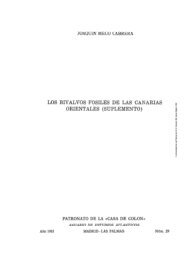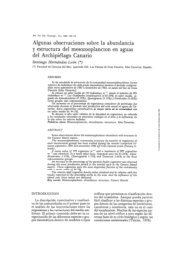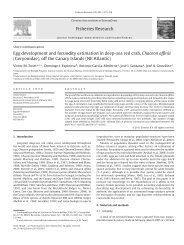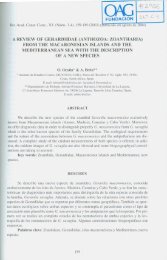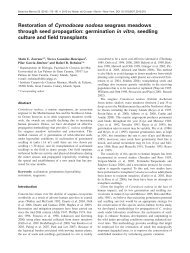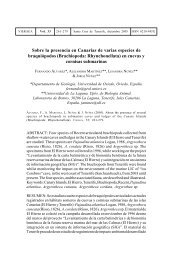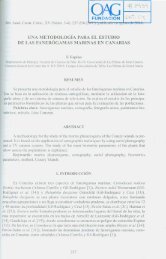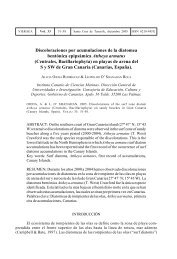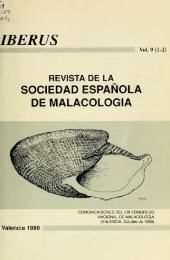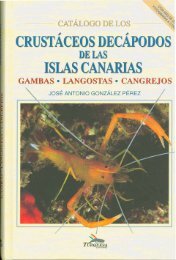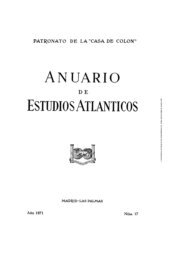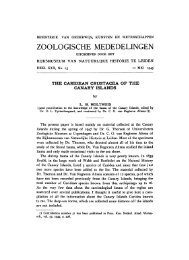of the madeira and selvagens archipelagos - redmic
of the madeira and selvagens archipelagos - redmic
of the madeira and selvagens archipelagos - redmic
Create successful ePaper yourself
Turn your PDF publications into a flip-book with our unique Google optimized e-Paper software.
4. Evolução em ilhas hiperdiversas<br />
Os arquipélagos da Madeira e Selvagens são claramente<br />
um hotspot de diversidade em número de espécies de<br />
artrópodes terrestres endémicos, com cerca de 979 espécies<br />
e subespécies registadas (ver Quadro 2). As ordens<br />
que, em geral, noutras regiões, têm um gr<strong>and</strong>e número de<br />
espécies endémicas são -no também nas ilhas da Madeira<br />
e Selvagens (Quadro 2): Coleoptera, com 416 taxa endémicos<br />
(40% de endemismo); Hymenoptera, com 107 taxa<br />
(18% de endemismo); Diptera, com 80 taxa (14% de endemismo);<br />
e Lepidoptera, com 81 taxa endémicos (25%<br />
de endemismo). À semelhança dos Coleoptera, existem<br />
outros grupos de artrópodes terrestres que também apresentam<br />
taxas elevadas de endemismo: Diplopoda (37 taxa,<br />
62%), Trichoptera (8 taxa, 61%), Crustacea Malacostraca<br />
– Amphipoda e Isopoda (30 taxa, 53%), ácaros (Acari<br />
Prostigmata) (27 taxa, 43%), pseudoscorpiões (Arachnida<br />
– Pseudoscorpiones) (8 taxa, 35%) e aranhas (Arachnida –<br />
Araneae) (58 taxa, 32%). Notável é o facto de duas ordens<br />
de insectos, as ordens Microcoryphia e Ephemeroptera,<br />
ambas com três espécies, terem 100% de endemismos.<br />
Ao nível taxonómico da família, os grupos com maior número<br />
de espécies e subespécies endémicas são os Curculionidae<br />
(gorgulhos e escolitídeos, 99), os Carabidae (76),<br />
os Staphylinidae (67), os Ichneumonidae (vespas parasíticas,<br />
32), os Julidae (diplópodes, 31), os Tenebrionidae (30)<br />
e os Anobiidae (29). No total, 94 famílias têm mais de 50%<br />
de espécies e subespécies endémicas, 14 das quais com<br />
10 ou mais taxa. Não podemos deixar de realçar o número<br />
de famílias de artrópodes (47) constituídas só por taxa endémicos.<br />
Inclusivamente, seis das 47 famílias têm cinco ou<br />
mais taxa: Torrenticolidae (10), Lauxaniidae (8), Byrrhidae<br />
(7), Empididae (6), Cixiidae (5) e Hygrobatidae (5).<br />
A curva de acumulação da descoberta de novas espécies<br />
e subespécies de artrópodes endémicas nos arquipélagos<br />
da Madeira e Selvagens (ver Fig. 2) ilustra o tempo<br />
que foi necessário para atingir o conhecimento que temos<br />
hoje acerca deste grupo animal. O trabalho realizado por<br />
Thomas Vernon Wollaston e publicado entre 1854 e 1871<br />
é, claramente, um dos marcos mais importantes no estudo<br />
dos artrópodes endémicos nas ilhas da Madeira e Selvagens<br />
(Machado 2006). Em 1859 estavam descritos 281 taxa<br />
endémicos (cerca de 30% do número total de espécies e<br />
subespécies endémicas actualmente descritas). Em 1959,<br />
o número de descrições de taxa endémicas tinha duplicado<br />
(60% do número de descrições actual). Com as publicações<br />
de 1960 a 1999, atingiu -se 90% das descrições actuais<br />
(Fig. 2). O número de novas espécies e subespécies<br />
descritas em relação ao número de taxa anteriormente conhecido<br />
por década tem variado ao longo do tempo, mas é<br />
particularmente elevada entre 1850 e 1860 e, mais recentemente,<br />
de 1980 até ao presente (ver Fig. 2).<br />
252<br />
4. Evolution in hyperdiverse isl<strong>and</strong>s<br />
The Madeira <strong>and</strong> Selvagens <strong>archipelagos</strong> are clearly a<br />
hotspot in terms <strong>of</strong> endemic species <strong>of</strong> terrestrial arthropods,<br />
with about 979 unique species <strong>and</strong> subspecies (see Table<br />
2). The worldwide hyperdiverse orders are also <strong>the</strong> most<br />
speciose (Table 2): beetles (Coleoptera) with 416 taxa (40%<br />
endemism), wasps, bees <strong>and</strong> ants (Hymenoptera) with 107<br />
taxa (18% endemism), flies (Diptera) with 80 taxa (14% endemism),<br />
<strong>and</strong> moths <strong>and</strong> butterflies (Lepidoptera) with 81<br />
taxa (25% endemism). O<strong>the</strong>r groups <strong>of</strong> terrestrial arthropods,<br />
besides beetles, also have high rates <strong>of</strong> endemism:<br />
millipedes with 62% <strong>of</strong> endemics (37 taxa), caddisflies with<br />
61% <strong>of</strong> endemics (8 taxa), wood lice (Crustacea –Malacostraca:<br />
Amphipoda <strong>and</strong> Isopoda) with 53% <strong>of</strong> endemics (30<br />
taxa), mites (Acari– Prostigmata) with 43% <strong>of</strong> endemics (27<br />
taxa); pseudoscorpions (Arachnida – Pseudoscorpiones)<br />
with 35% <strong>of</strong> endemics (8 taxa); <strong>and</strong> spiders (Arachnida<br />
– Araneae) with 32% <strong>of</strong> endemics (58 taxa). Remarkably,<br />
two small insect orders (Microcoryphia <strong>and</strong> Ephemeroptera)<br />
both have only three species, but all are endemic to <strong>the</strong> Madeira<br />
<strong>and</strong> Selvagens <strong>archipelagos</strong> – 100% endemism.<br />
The most diverse arthropod families in terms <strong>of</strong> endemic<br />
species <strong>and</strong> subspecies are: Curculionidae (snout <strong>and</strong> bark<br />
beetles) with 99 taxa, Carabidae (ground -beetles) with 76<br />
taxa, Staphylinidae (rove -beetles) with 67 taxa, Ichneumonidae<br />
(ichneumonid parasitic wasps) with 32 taxa, Julidae<br />
(julid millipedes) with 31 taxa, Tenebrionidae (darkling beetles)<br />
with 30 taxa <strong>and</strong> Anobiidae (death -watch <strong>and</strong> spider-<br />
-beetles) with 29 taxa, Remarkably, a total <strong>of</strong> 47 arthropod<br />
families are composed only <strong>of</strong> endemic taxa, six <strong>of</strong> <strong>the</strong>m<br />
with five or more taxa (Torrenticolidae – 10, Lauxaniidae – 8,<br />
Byrrhidae – 7, Empididae – 6, Cixiidae – 5, <strong>and</strong> Hygrobatidae<br />
– 5). Moreover, 94 <strong>of</strong> <strong>the</strong> families have more than 50%<br />
<strong>of</strong> endemic species <strong>and</strong> subspecies, 14 <strong>of</strong> <strong>the</strong>m with 10 or<br />
more taxa.<br />
The cumulative new endemic taxa’ discovery curve for<br />
species <strong>and</strong> subspecies <strong>of</strong> arthropods (see Fig. 2) illustrates<br />
<strong>the</strong> considerable amount <strong>of</strong> time taken to achieve <strong>the</strong><br />
current state <strong>of</strong> knowledge on <strong>the</strong> endemic arthropods from<br />
<strong>the</strong> Madeira <strong>and</strong> Selvagens <strong>archipelagos</strong>. The work <strong>of</strong> Thomas<br />
Vernon Wollaston on <strong>the</strong>se isl<strong>and</strong>s, published between<br />
1854 <strong>and</strong> 1871, is clearly <strong>the</strong> major l<strong>and</strong>mark in <strong>the</strong> study <strong>of</strong><br />
<strong>the</strong> arthropods from <strong>the</strong> Madeira <strong>and</strong> Selvagens <strong>archipelagos</strong><br />
(Machado 2006). This is illustrated by <strong>the</strong> fact that, by<br />
1859, about 281 endemic species <strong>and</strong> subspecies (±30%)<br />
had already been described. It took ano<strong>the</strong>r century before<br />
<strong>the</strong> number <strong>of</strong> descriptions <strong>of</strong> endemic species <strong>and</strong> subspecies<br />
duplicated: by 1959, 60% <strong>of</strong> <strong>the</strong> presently known<br />
endemic taxa had been described. With <strong>the</strong> descriptions <strong>of</strong><br />
species <strong>and</strong> subspecies published between 1960 <strong>and</strong> 1999<br />
<strong>the</strong> percentage <strong>of</strong> <strong>the</strong> Madeira <strong>and</strong> Selvagens endemic arthropod<br />
taxa reaches 90% (Fig. 2). The crude growth rate<br />
(<strong>the</strong> number <strong>of</strong> new taxa described over <strong>the</strong> total number <strong>of</strong><br />
taxa described) varies greatly, being noticeably higher between<br />
1850 -1860 <strong>and</strong>, more recently, between1980 -2008<br />
(see Fig. 2).



